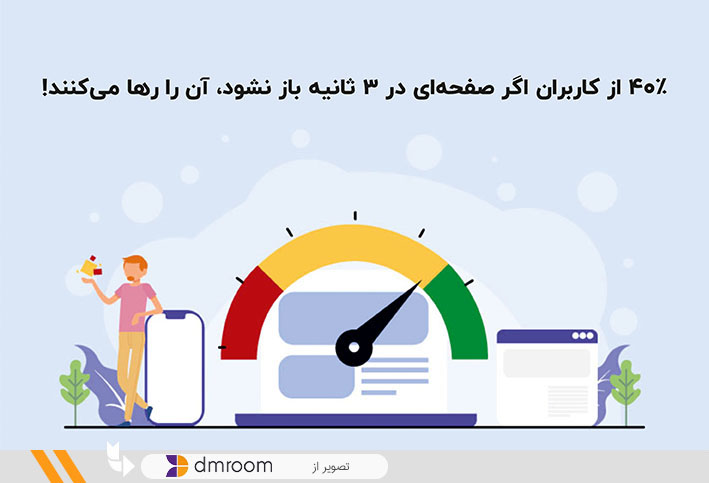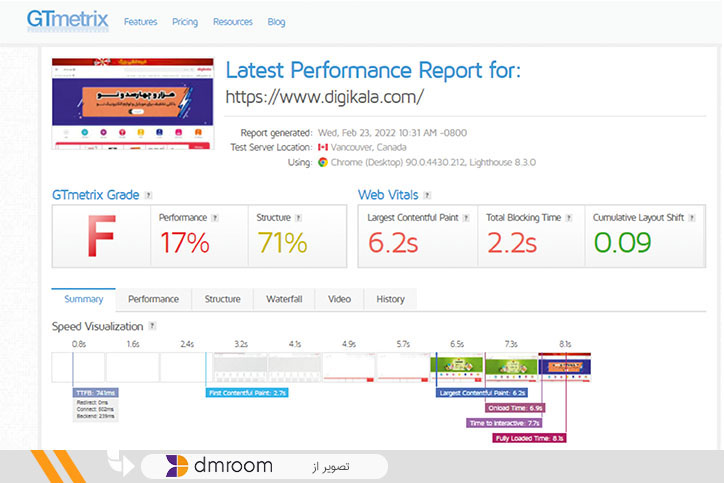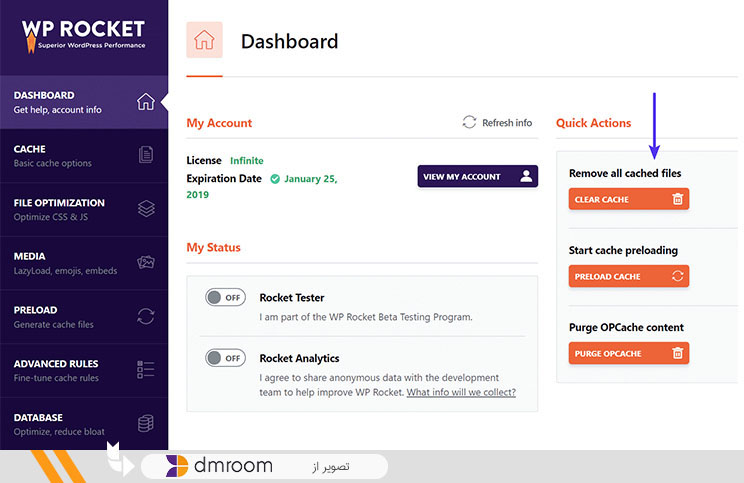Why should we take site speed optimization seriously?
You may not believe it, but optimizing site speed is one of the measures that is directly related to site ranking and user experience of our audience. There is nothing worse than taking all the necessary steps for SEO, but forgetting to increase the speed of the site!
Site speed optimization is the beating heart of the user experience and is more than anything else involved in improving the user experience and increasing the site‘s natural click-through rate. If you have not yet taken the issue of site speeding seriously, read on to find out the various effects of site speed in SEO, and get acquainted with immediate and professional solutions to increase site speed.
Why should we take site speed optimization seriously?
Perhaps the first question that comes to your mind is what is the importance of optimizing the speed of the site? In response, research shows that a user only waits between 0.3 and 3 seconds for a site to open. If it takes longer for our site to load to display more information, the user will lose focus and possibly close the browser window!
Sites with higher loading speeds will have lower bounce rates, higher conversion rates, and better ranking in organic search results, and more importantly, will provide a better user experience to your audience. Slow sites are officially wasting SEO and site maintenance costs and damaging our brand. On the other hand, faster loading of our site pages will have a positive effect on traffic, user retention and better sales. In the following, we will examine the effects of site speed in SEO in detail.
The importance of site speed optimization in technical SEO
Google has repeatedly stated that the speed of sites is one of the most important factors in their ranking, because it is directly related to the user experience of using the site. This is exactly why Google unveiled the Mobile First Index algorithm in 2018. With the unveiling of this algorithm, sites, in addition to the web version, had to take action to speed up their mobile version. But the issue does not end here, site speed optimization has an impact on technical SEO in two dimensions:
1. Optimize site speed and improve user experience or UX
Increasing the speed of the site improves the user experience. If our site loads faster, the user will stay on the site longer, and this is great for Google!
Improving the user search experience is Google’s first and foremost goal. For this reason, it implemented the first mobile algorithm so that sites, in addition to speeding up the desktop version of sites, also work on optimizing the mobile version of their site and improving the user experience of audiences who use mobile to search Google.
2. Optimize site speed and increase conversion rates
Slow sites eliminate conversion rates. The conversion rate may not be directly related to SEO, but if you know that according to Google statistics, 47% of visitors prefer sites to open in less than 2 seconds, you will change your mind!
According to the same statistic, 40% of users leave a page if it does not open in 3 seconds. This means that if our site takes more than three seconds to load, we will lose almost half of our visitors before they enter the site. This alone will have a huge impact on the potential conversion rate, as it is very unlikely that they will return to our site after this experience. To better understand this issue, we suggest you review the ” SEO ” article .

Get acquainted (gain, obtain) with present-day techniques that came from Core Vital Web
Now that the importance of site speed optimization in SEO is clear to us, it’s time to get acquainted with Google’s critical core factors for assessing site speed. Core Web Vital is a set of metrics that Google introduced in 2021 to evaluate key aspects of the user experience when a site loads. These factors include:
Lcp (Largest Contentful Paint)
The first and most important criterion of Core Web Vitals is the Lcp value of the site. This metric indicates how long it takes for the site’s largest content to be displayed to users. Lcp is used to measure the full rendering time of the main content element of a page.
Cls (Cumulative Layout Shift)
What is CLS? It is an important and user-centric criterion for evaluating the visual stability of a site. This measure measures sudden changes in site layout, or so-called bounce, during loading. The lower the CLS, the better the site user experience.
Ttfb (Time To First Byte)
What is TTFB? The interval is when the browser connects to the server. This criterion measures the exact time between the first connection to the server and the loading of site content. The higher the number, the longer it takes for the site to be displayed to the user.
Tti (Time To Interactive)
Tti is the time it takes for a page to become interactive. This interactivity includes valuable content, the time it takes to load visible elements, and the page responds to user interaction in 50 milliseconds. For more information on optimizing this, we suggest reading the article ” What is tti? “
Tbt (Total Blocking Time)
Tbt along with Lcp is the most important benchmark for our site in Page Speed Insights. This is a measure of how users interact with the page and measures how long a page is unable to receive input from users. For more information on optimizing this, we suggest you read the article ” What is tbt? “
Google measures these factors to rate the speed of our site. Optimizing your site speed requires improving your site ranking on each of these factors. In the next section, we will introduce site optimization methods.

Website speed optimization training with 14 instant and professional methods
In this free SEO tutorial , we want to introduce methods that you can use to significantly increase the speed of your site. There are several ways to optimize site speed, but we will introduce the best and most practical ones to you:
1. Use high-speed hosting to increase site speed
The first and most important factor in increasing the speed of the site is the choice of high speed hosts. Hosting has a huge impact on slowing down or speeding up the site, and unfortunately most SEOs are not aware of this. To buy hosts, we should not even go to shared hosts, because we have several other sites on a dedicated server, and their use of this resource will slow down our site.
2. Activate LAZY LOAD
Normally when we enter a page, the browser starts downloading all the elements and images of the site. This process, despite thousands of codes and images, may take more than 5 seconds, and this will cause user fatigue and increase the site bounce rate. LAZY LOAD allows the browser to download only the visible parts of the page after entering the site and to load the lower parts as the user scrolls.
3. Optimize your site template
Site template optimization is one of the factors in optimizing site speed. There are several factors in coding templates, including old and non-standard code, a lot of comment code, excessive use of js code, heavy images and inline css code, which can slow down the site. These factors can be modified in custom formats, but can not be changed in ready-made formats and you must replace the site template.
4. Optimize the size of the site images
You may not believe it, but reducing the size of images on the site, significantly helps to increase its speed. Bulk images prevent site optimization speed by slow loading and filling the browser cache. To do this, we need to know the size of the images on different pages of the site and design the images according to those dimensions. Also in Photoshop software, change the size of the images to a minimum. We suggest that you read the article on image size reduction software.
5. Optimize the home page of the site
The main page of the site is the most visited page of the site. So fast loading is more important than any other page. This page should be optimized from the structure to the images and elements. Site optimization, footer and sidebar optimization is of particular importance. Also, the icons of different sections of the site should be optimized in terms of site slowdown factors.
6. Use the browser cache
Different browsers store a lot of information such as images, JavaScript files, etc. تا so that the next visitor does not have to reload the entire page. Site cache is a feature that increases the loading speed of the site and helps to improve the user experience. We can use reputable plugins like wp-super-cash or w3-total-cash to manage the cache of WordPress sites.
7. Use a CDN or content distribution network
A CDN, or Content Distribution Network, is a collection of servers located in different parts of the world whose job it is to store a copy of our site for users. In this way, when the user wants to connect to our site, the nearest server sends us our information. Using a CDN is very useful for sites hosted abroad, as it helps speed up the site.
8. Identify and delete 404 pages
404 pages cause a sharp drop in site speed by creating additional requests. There are several tools to identify these pages, the best and fastest of which is Website Auditor. After identifying these pages with the help of 301 redirect plugins, we redirect these pages to the most relevant page of the site. For more information, we suggest you read the article What is a 301 redirect .
9. Remove extra plugins on WordPress sites
Plugins are the most attractive and useful tools designed to better manage WordPress sites. However, excessive installation of these plugins will slow down the site due to their constant updating. These plugins are also made of code, the increase of which can also reduce the speed.
10. Remove unnecessary site sliders
Sliders make the home page and internal pages of the site beautiful and attractive. But these attractive elements reduce the speed of the site. The sliders are made of high quality images, which makes the loading of our site pages slow.
11. Update php site
In WordPress sites, in addition to updating the WordPress kernel and plugins that are done automatically, we sometimes have to update the php version of the site through the hosting panel. The new version of php can have great effects on optimizing the speed of our site. So how much better to pay special attention to it.
12. Enable the Google PageSpeed module on the site
Google has designed the google page speed tool to improve the user experience of the audience. By activating the module of this tool, it automatically takes the best steps to optimize the speed of the site. Just download this tool and activate it on the site web server.
13. Compress css, JavaScript and HTML files seriously
A large part of the size of each page is css, html and js code. Optimizing these codes can significantly increase the speed of the site. Google’s recommended tools for compressing this code are CSSNano and UglifyJS.
14. Delete Google fonts
Removing Google fonts is another factor in improving the loading speed of the site. The existence of Google font code snippet has practically no use in Persian sites and only increases the number of site requests. So how much better to remove this code and help speed up our site.
Introducing 2 practical tools for testing site speed!
To know if our site needs speed optimization or not, we need the help of tools. The tools evaluate the speed of different pages of the site and tell us exactly where the problem of site speed is. Here are some of them:
Google Page Speed tool
This tool is one of Google’s free products that we can only use with the filter breaker at the moment. This tool is based on Lighthouse and uses field data to evaluate the site. This data is collected by Chrome’s user experience report, and we can see how the page we want works according to users’ tastes.
GTMetrix tool
GTmetrix is one of the most popular tools for measuring site speed. This tool provides important reports such as page speeds, Core Vital Web factor values for speed, YSlow, Waterfalls as well as visual reports of the historical data of the pages under review completely free of charge.

Google Chrome extensions to test site speed
Google Chrome provided some free plugins to test the speed of the site, the names of which are listed below to get from the Extension section of Google Chrome.
- Page Load Time
- telemetry Page Speed Monitor
- Performance Analyzer
- LoadFocus Load Testing
Introducing the best WordPress site speed optimization plugins
One of the most important parts of this article is learning how to optimize site speed, recognizing plugins that install in WordPress panel helps to automatically improve the speed of these sites. In the following, we will introduce them to you:
WP Rocket Plugin
Rocket plugin is the best plugin to speed up WordPress sites. This plugin can do a few important steps to optimize the speed of the site alone, just buy a copy of it. In the following, we will get acquainted with the important and useful features of this plugin:
- Compression of css, JavaScript and HTML code
- Enable load or slip load mode
- Activate the JSIP site feature
- Browser cache capability support
- JS code load control
- Optimize Google Fonts

Wp-optimize plugin
wp optimize is the second speed optimization plugin for WordPress sites. This plugin helps to increase the speed of the site by optimizing the site database. The wp optimize plugin deletes spam comments, deleted items and all extras of the database and makes the site more agile.
Of course, in addition to these two popular plugins, there are other plugins that we will only mention their names:
- w3 total cache; Site cache optimization
- smush it; Optimizing the size and size of site images
- AUTOPTIMIZE; Optimize the number of server requests
- a3 Lazy Load; Activate the ability to load or slip lazy
Is site optimization better in the desktop version or the mobile version?
As we said at the beginning, the speed of the site is tied to the user experience. Slowly loading pages have a high bounce rate and users run away from them. These pages even cause problems with the site conversion rate, because users do not have the patience to wait.
According to statistics published by Google, more than 55% of users used mobile phones for their Internet searches, even in some areas this figure had reached nearly 80%! The same change in users’ behavior and their desire to search for mobile, caused Google to implement the Mobile First Index algorithm so that mobile users also enjoy searching the web and are less likely to encounter unresponsive and slow sites. So if we want our site to rank better, we must also take site speed optimization in the mobile version seriously.
Frequently Asked Questions
Should we use all these tools to test the speed of the site?
No. But using Google’s free tool, Google Page Speed Insight, is more recommended.
What can we do to improve the speed of our shopping sites?
We suggest designing a responsive template, improving the speed of the desktop version and increasing the speed of the mobile version. Reducing the size of images can also be a good way to improve speed.
What effect does hosting have on increasing site speed?
Website hosting plays an important role in its speed. So that a weak host can disrupt all your SEO efforts and programs.
Concluding remarks
Finally, we recommend that you take the issue of site speed optimization seriously. Check the status of site speed in both desktop and mobile versions, and if you need to optimize, use the strategies of the site speed optimization training section. If you can reduce the speed of the site to less than 3 seconds, it will undoubtedly have a significant impact on improving SEO and site ranking.










